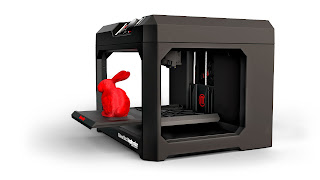3D Printing is the technological ability to recreate exact replicates of 3D images into actual physical objects. In other words, people can now literally recreate into physical form whatever comes to their mines in a matter of hours. Such a capability is surely going to revolutionize several industries and with that it will have a significant impact on our lives.
Believe it or not 3D printing started and has been around since the
1980’s. However, it’s taken the industry close to 30 years to perfect and bring
this technology to light because of the enormous amount of R &D that is
required to create patents, plus the long amount of time it takes to officially
get those patents finalized by the government. Not to mention the complexity of
a 3D printer, it took companies quite a bit of time to create a prototype in
order to be used to create other prototypes.
At the moment there are 3 major markets for 3D printers, the first is the
manufacturing industry, second is service based companies, and third is the
consumer market.
The primary
buyers for 3D printers are manufacturers, as a major portion of their work is
focused on creating products for the mass market which require a lot of
prototyping and testing. 3D printers have accelerated this process substantially
because of the increased speed of producing prototypes at an even cheaper cost.
In terms of service companies, the market potential is nearly endless as
the use for 3D printers is extremely diverse. In the health industry,
businesses in the Japan have begun using 3D printers to make human teeth which
can be used for patents whenever they need a tooth replacement in the future.
In the fashion industry businesses may now create even more complex and
customized shaped jewelry for customers. In real estate, architects may now easily
display physical models instead of blue prints in front of construction companies
and home owners before making a final decision on constructing their buildings.
Finally, the market for consumers is still relatively in the early
stages, since not everyone has the skill set to use a 3D printer, additionally
uses for customers are presently limited. People that do own them tend to
create simple objects like toys and model cars or airplanes. Others with higher
skills in design can produce more sophisticated objects like antique items and
art.
This technology is not without its controversies. Some in the
manufacturing industry claim that the government will not be able to enforce
copy right laws on to owners of 3D printers in order to prevent them for
eventually using a manufactures designs to produces their own products at home.
Furthermore, recently in the news consumers with the use of 3D printers have
been able to print fully functional fire arms without a license or serial
number to trace the weapon which may assist criminals in getting away with
crime.
The question to ask now, where is 3D printing going? And how will it
affect us? After a general analysis and observation of how current businesses
and consumer use 3D printing, we can say for sure that people worldwide will be
seeing more things being customized to their liking, an even more accelerated
rise in innovation, and higher quality products being produced due to the high
precision in manufacturing standards.
Photo 1 Courtesy of: www.blog.cnccookbook.com
Photo 2 Courtesy of: www.monroestreetstudio.com
Photo 1 Courtesy of: www.blog.cnccookbook.com
Photo 2 Courtesy of: www.monroestreetstudio.com







